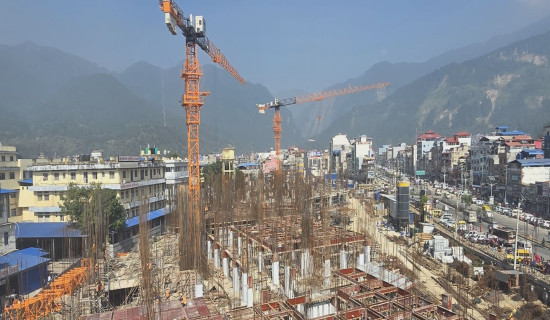- Sunday, 7 December 2025
Aged Workforce On Rise
In many developing countries, people need to work regardless of their age. Although most nations have laws preventing child labour, many children from below the poverty line and low-income families still engage in income-generating activities. Similarly, while most countries have a set retirement age — usually between 60 and 65 — poverty often compels people to work beyond that age. In Nepal, for instance, farmers in their sixties and seventies continue to work in their fields, especially when it's necessary to meet their families’ basic needs.
According to the International Labour Organisation (ILO), the world’s population is aging, which has major implications for the future workforce. By 2035, the number of people aged 55 and above is expected to surpass the number of children aged 0–14. By 2080, this age group will outnumber the entire child and youth population aged 0–24. As a result, the number of older workers aged 55 to 64 is rising and is projected to make up one-quarter of the global labour force by 2030. According to Research Gate, the proportion of older people in Nepal is increasing rapidly. There are 2.97 million older people as of the 2021 census, which is a 38.2 per cent increase compared to the previous census of 2011.
Labour-intensive work
In developed and wealthy nations, while most labour-intensive work is typically done by migrant workers, there is now a growing trend of people over 60 seeking jobs for various personal reasons. A report, published by the Korea Herald on March 9, 2025, revealed that 29 per cent of all job seekers in South Korea as of January 2025 were aged 60 or above. The report noted that more elderly individuals are now looking for work than ever before. According to the Korea Employment Information Service, 4.52 million people registered as job seekers on the state-run job portal Worknet in 2024 — a 5.3 per cent decrease from 4.77 million in 2023. By age group, those in their twenties comprised the largest segment at 1.07 million, followed by those aged 60 and above.
The report noted that since 2023, individuals in the 60-plus group have been the second-largest category of job seekers, surpassing those in their forties and fifties for the first time. In 2024, the South Korean government officially declared the country a "super-aged society," meaning over 20 per cent of the population is 65 or older. As of December 2024, that figure stood at exactly 20 per cent. With a high cost of living, many elderly individuals in wealthy countries like South Korea continue working past retirement age. These individuals often hold short-term positions, which leads to frequent job hunting.
For example, in Seoul, metro rides are free for people over 65. Many courier companies take advantage of this by hiring elderly individuals, especially those in their seventies, as delivery personnel, which helps reduce operating costs. Since pensions are relatively low, even retired engineers and technical professionals take up such roles to supplement their income. These jobs also offer the flexibility to work limited hours, depending on health and personal comfort. Several companies in South Korea have been established specifically to provide employment opportunities for the aging population, balancing operational cost-saving with meaningful engagement for seniors.
According to a report by CNA, one in four South Koreans aged 70 or above holds some form of employment, with more than 40 per cent in low-skilled jobs. These septuagenarians may be retired experts who now take on such roles to stay active, earn extra income, or simply remain engaged. The report also highlights that South Korea has the highest old-age poverty rate among the 38 member countries of the Organisation for Economic Co-operation and Development (OECD), with four in ten seniors living below the poverty line.
As the world races ahead in creating wealth and embracing high-tech lifestyles, it is crucial to pause and reflect: Where are we heading? If four out of ten elderly individuals in an affluent country like South Korea live below the poverty line, what does that say about the true impact of development? In developing countries like Nepal, many elderly people from low-income backgrounds must continue working to survive. Increasingly, older adults are also left to live alone due to the migration of their children in search of better job opportunities abroad. Consequently, many suffer from loneliness and a lack of meaningful employment or daily engagement.
Weak social support
While social interaction and community activities may provide some relief, weak social support systems often leave even affluent elderly individuals struggling to receive adequate care, especially when their children are abroad. Among families living below the poverty line, older adults must work regardless of age. If they are abandoned by their children, they often have no refuge, as there are very few elderly homes run by the government or NGOs. These limited facilities cannot meet the growing demand.
As the issue of elderly individuals needing employment for economic, emotional, or social reasons becomes more widespread, countries must begin to plan for suitable employment opportunities and engagement for their aging populations. Companies, too, should consider hiring older adults — not only to reduce costs but also to contribute to their social well-being. According to the U.S. Bureau of Labour Statistics, adults aged 65 and older are projected to comprise 8.6 per cent of the labour force by 2032, up from 6.6 per cent in 2022. Over this period, older adults are expected to account for 57 per cent of labour force growth.
(Sharma is a senior journalist and women’s rights advocate. namrata1964@yahoo.com or on X @NamrataSharmaP.)
















